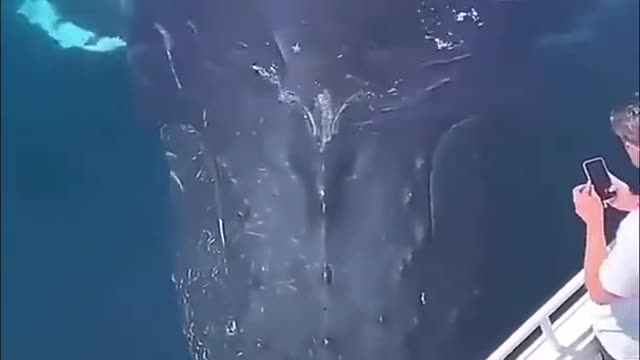Premium Only Content

Nice big fish video
Welcome my fk animal channel
Nice big fish video
Whale
Sea Animal
Whales are a widely distributed and diverse group of fully aquatic placental marine mammals. They are an informal grouping within the infraorder Cetacea, usually excluding dolphins and porpoises. Whales, dolphins and porpoises belong to the order Cetartiodactyla, which consists of even-toed ungulates.
Phylum: Chordata
Order: Artiodactyla
Lifespan: Blue whale: 80 – 90 years, Killer whale: 29 years
Mass: Blue whale: 50,000 – 150,000 kg, MORE Encyclopedia of Life
Length: Blue whale: 25 m, Killer whale: 6 – 8 m, MORE Encyclopedia of Life
Gestation period: Blue whale: 10 – 12 months
Whale, any of the larger species of aquatic mammals belonging to the order Cetacea. The term whale can be used in reference to any cetacean, including porpoises and dolphins, but in general it is applied to those more than 3 metres (10 feet) long.
An exception is the 2.7-metre dwarf sperm whale (Kogia simus), so called for its otherwise striking resemblance to its larger namesake. Whales are the heaviest known animals, living or fossil, reaching a maximum size in the blue whale (Balaenoptera musculus) of perhaps more than 30 metres and 200 metric tons (220 short [U.S.] tons).
Whales are distributed throughout the world’s oceans and seas, from the Equator to the polar ice, except for the landlocked Caspian and Aral seas. They are mammals, and they share the defining traits of
that group: they breathe air, are warm-blooded, give live birth, suckle their young on milk, and have hair. All are entirely aquatic, with specialized adaptations such as flippers and tail flukes for living in water.
Whales must surface regularly to breathe, evacuating their lungs more completely than most mammals in an almost explosive breath known as a blow. Blows are visible because water vapour in the whale’s hot breath condenses when the blow is released.
Despite living in a medium that has much greater thermal conduction characteristics than air, whales, like other mammals, must regulate their body temperature.
Hair, however, is restricted to the head, appearing mainly as isolated whiskers (vibrissae) near the mouth and blowhole. Blubber serves as an insulating layer to protect small whales from hypothermia.
Large whales have the opposite problem in that they can produce too much heat; they possess elaborate thermoregulation mechanisms to prevent overheating.
Biology Of Whale
Etymology and definitions
The word "whale" comes from the Old English hwæl, from Proto-Germanic *hwalaz, from Proto Indo European *(s)kwal-o-, meaning "large sea fish".
The Proto-Germanic *hwalaz is also the source of Old Saxon hwal, Old Norse hvalr, hvalfiskr, Swedish val, Middle Dutch wal, walvisc, Dutch walvis, Old High German wal, and German Wal.
The obsolete "whalefish" has a similar derivation, indicating a time when whales were thought to be fish.[citation needed] Other archaic English forms include wal, wale, whal, whalle, whaille, wheal, etc.
The term "whale" is sometimes used interchangeably with dolphins and porpoises, acting as a synonym for Cetacea. Six species of dolphins have the word "whale" in their name, collectively known as blackfish: the killer whale, the melon
-headed whale, the pygmy killer whale, the false killer whale, and the two species of pilot whales, all of which are classified under the family Delphinidae (oceanic dolphins). Each species has a different reason for it, for example, the killer whale was named "Ballena asesina" 'killer whale' by Spanish sailors.
The term "Great Whales" covers those currently regulated by the International Whaling Commission: the Odontoceti family Physeteridae (sperm whales); and the Mysticeti families Balaenidae (right and bowhead whales), Eschrichtiidae (grey whales), and some of the Balaenopteridae (Minke, Bryde's, Sei, Blue and Fin; not Eden's and Omura's whales).
Mysticetes
Mysticetes are also known as baleen whales. They have a pair of blowholes side-by-side and lack teeth; instead they have baleen plates which form a sieve-like structure in the upper jaw made of keratin, which they use to filter plankton from the water. Some whales, such as the humpback, reside in the polar regions where they feed on a reliable source of schooling fish and krill.
These animals rely on their well-developed flippers and tail fin to propel themselves through the water; they swim by moving their fore-flippers and tail fin up and down. Whale ribs loosely articulate with their thoracic vertebrae
at the proximal end, but do not form a rigid rib cage. This adaptation allows the chest to compress during deep dives as the pressure increases.
Mysticetes consist of four families: rorquals (balaenopterids), cetotheriids, right whales (balaenids), and grey whales (eschrichtiids).
The main difference between each family of mysticete is in their feeding adaptations and subsequent behaviour. Balaenopterids are the rorquals. These animals, along with the cetotheriids, rely on their throat pleats to gulp large amounts of water while feeding.
The throat pleats extend from the mouth to the navel and allow the mouth to expand to a large volume for more efficient capture of the small animals they feed on. Balaenopterids consist of two genera and eight species.
Balaenids are the right whales. These animals have very large heads, which can make up as much as 40% of their body mass, and much of the head is the mouth.
This allows them to take in large amounts of water into their mouths, letting them feed more effectively. Eschrichtiids have one living member: the grey whale. They are bottom feeders, mainly eating crustaceans and benthic invertebrates.
They feed by turning on their sides and taking in water mixed with sediment, which is then expelled through the baleen, leaving their prey trapped inside. This is an efficient method of hunting, in which the whale has no major competitors.
Odontocetes
Odontocetes are known as toothed whales; they have teeth and only one blowhole. They rely on their well-developed sonar to find their way in the water. Toothed whales send out ultrasonic clicks using the melon. Sound waves travel through the water.
Upon striking an object in the water, the sound waves bounce back at the whale. These vibrations are received through fatty tissues in the jaw, which is then rerouted into the ear-bone and into the brain where the vibrations are interpreted.
All toothed whales are opportunistic, meaning they will eat anything they can fit in their throat because they are unable to chew. These animals rely on their well-developed flippers and tail fin to propel themselves through the water; they swim by moving their fore-flippers and tail fin up and down.
Whale ribs loosely articulate with their thoracic vertebrae at the proximal end, but they do not form a rigid rib cage. This adaptation allows the chest to compress during deep dives as opposed to resisting the force of water pressure.
Excluding dolphins and porpoises, odontocetes consist of four families: belugas and narwhals (monodontids), sperm whales (physeterids), dwarf and pygmy sperm whales (kogiids), and beaked whales (ziphiids).
There are six species, sometimes referred to as "blackfish", that are dolphins commonly misconceived as whales: the killer whale, the melon-headed whale, the pygmy killer whale, the false killer whale, and the two species of pilot whales, all of which are classified under the family Delphinidae (oceanic dolphins).
Evolution
Whales are descendants of land-dwelling mammals of the artiodactyl order (even-toed ungulates). They are related to the Indohyus, an extinct chevrotain-like ungulate, from which they split approximately 48 million years ago.
Primitive cetaceans, or archaeocetes, first took to the sea approximately 49 million years ago and became fully aquatic 5–10 million years later.
What defines an archaeocete is the presence of anatomical features exclusive to cetaceans, alongside other primitive features not found in modern cetaceans, such as visible legs or asymmetrical teeth.
Their features became adapted for living in the marine environment. Major anatomical changes included their hearing set-up that channeled vibrations from the jaw to the earbone (Ambulocetus 49 mya), a streamlined body and the growth
of flukes on the tail (Protocetus 43 mya), the migration of the nostrils toward the top of the cranium (blowholes), and the modification of the forelimbs into flippers (Basilosaurus 35 mya), and the shrinking and eventual disappearance of the hind limbs (the first odontocetes and mysticetes 34 mya).
Whale morphology shows a number of examples of convergent evolution, the most obvious being the streamlined fish-like body shape.
Other examples include the use of echolocation for hunting in low light conditions — which is the same hearing adaptation used by bats — and, in the rorqual whales, jaw adaptations, similar to those found in pelicans, that enable engulfment feeding.
Anatomy
Whales have torpedo shaped bodies with non-flexible necks, limbs modified into flippers, non-existent external ear flaps, a large tail fin, and flat heads (with the exception of monodontids and ziphiids).
Whale skulls have small eye orbits, long snouts (with the exception of monodontids and ziphiids) and eyes placed on the sides of its head. Whales range in size from the 2.6-metre (8.5 ft) and 135-kilogram (298 lb) dwarf sperm whale to the 34-metre (112 ft) and 190-metric-ton (210-short-ton) blue whale.
Overall, they tend to dwarf other cetartiodactyls; the blue whale is the largest creature on earth. Several species have female-biased sexual dimorphism, with the females being larger than the males. One exception is with the sperm whale, which has males larger than the females.
Odontocetes, such as the sperm whale, possess teeth with cementum cells overlying dentine cells. Unlike human teeth, which are composed mostly of enamel on the portion of the tooth outside of the gum, whale teeth have cementum outside the gum.
Only in larger whales, where the cementum is worn away on the tip of the tooth, does enamel show. Mysticetes have large whalebone, as opposed to teeth, made of keratin. Mysticetes have two blowholes, whereas Odontocetes contain only one.
Locomotion
Whales have two flippers on the front, and a tail fin. These flippers contain four digits. Although whales do not possess fully developed hind limbs, some, such as the sperm whale and bowhead whale, possess discrete rudimentary appendages, which may contain feet and digits.
Whales are fast swimmers in comparison to seals, which typically cruise at 5–15 kn, or 9–28 kilometres per hour (5.6–17.4 mph); the fin whale, in comparison, can travel at speeds up to 47 kilometres per hour (29 mph) and the sperm whale can reach speeds of 35 kilometres per hour (22 mph).
The fusing of the neck vertebrae, while increasing stability when swimming at high speeds, decreases flexibility; whales are unable to turn their heads. When swimming, whales rely on their tail fin propel them through the water.
Flipper movement is continuous. Whales swim by moving their tail fin and lower body up and down, propelling themselves through vertical movement, while their flippers are mainly used for steering.
Some species log out of the water, which may allow them to travel faster. Their skeletal anatomy allows them to be fast swimmers. Most species have a dorsal fin.
Senses
The whale ear has specific adaptations to the marine environment. In humans, the middle ear works as an impedance equalizer between the outside air's low impedance and the cochlear fluid's high impedance.
In whales, and other marine mammals, there is no great difference between the outer and inner environments. Instead of sound passing through the outer ear to the middle ear, whales receive sound through the throat, from which it passes through a low-impedance fat-filled cavity to the inner ear.
The whale ear is acoustically isolated from the skull by air-filled sinus pockets, which allow for greater directional hearing underwater.
Odontocetes send out high frequency clicks from an organ known as a melon. This melon consists of fat, and the skull of any such creature containing a melon will have a large depression.
The melon size varies between species, the bigger the more dependent they are of it. A beaked whale for example has a small bulge sitting on top of its skull, whereas a sperm whale's head is filled up mainly with the melon.
Communications
Whale vocalization is likely to serve several purposes. Some species, such as the humpback whale, communicate using melodic sounds, known as whale song.
These sounds may be extremely loud, depending on the species. Humpback whales only have been heard making clicks, while toothed whales use sonar that may generate up to 20,000 watts of sound (+73 dBm or +43 dBw)[58] and be heard for many miles.
Captive whales have occasionally been known to mimic human speech. Scientists have suggested this indicates a strong desire on behalf of the whales to communicate with humans, as whales have a very different vocal mechanism, so imitating human speech likely takes considerable effort.
Whales emit two distinct kinds of acoustic signals, which are called whistles and clicks: Clicks are quick broadband burst pulses, used for sonar, although some lower-frequency broadband vocalizations may serve a non-echolocative purpose such as communication; for example, the pulsed calls of belugas.
Pulses in a click train are emitted at intervals of ≈35–50 milliseconds, and in general these inter-click intervals are slightly greater than the round-trip time of sound to the target. Whistles are narrow-band frequency modulated (FM) signals, used for communicative purposes, such as contact calls.
Life cycle
Whales are fully aquatic creatures, which means that birth and courtship behaviours are very different from terrestrial and semi-aquatic creatures. Since they are unable to go onto land to calve, they deliver the baby with the fetus positioned for tail-first delivery.
This prevents the baby from drowning either upon or during delivery. To feed the new-born, whales, being aquatic, must squirt the milk into the mouth of the calf. Being mammals, they have mammary glands used for nursing calves; they are weaned off at about 11 months of age.
This milk contains high amounts of fat which is meant to hasten the development of blubber; it contains so much fat that it has the consistency of toothpaste.
Females deliver a single calf with gestation lasting about a year, dependency until one to two years, and maturity around seven to ten years, all varying between the species.
This mode of reproduction produces few offspring, but increases the survival probability of each one. Females, referred to as "cows", carry the responsibility of childcare as males, referred to as "bulls", play no part in raising calves.
-
 1:39:35
1:39:35
Kevin Trudeau
8 hours agoKevin Trudeau: The Complete Creation Algorithm to Manifest Your Goals & Desires
1.93K4 -
 1:11:14
1:11:14
Ohio State Football and Recruiting at Buckeye Huddle
3 hours agoOhio State Football: Instant Reaction from the 14-7 win over Texas
2.29K1 -
 18:01
18:01
Tactical Advisor
1 hour agoNew Miniature AR15 / New Guns | Vault Room Live Stream 037
8.25K2 -
 2:02:10
2:02:10
Akademiks
4 hours agoWar in RAT-LANTA. Young Thug vs Gunna vs Ralo vs YSL MONDO. Who Will Le Bebe Pick. FINAL CRASHOUT!
35.4K7 -
 1:13:36
1:13:36
Jeff Ahern
4 hours ago $2.28 earnedThe Sunday Show with Jeff Ahern
19.7K6 -
 LIVE
LIVE
GoodLifeGaming
6 hours ago🔴LIVE - TARKOV PVP SOLO LEARNING - 2 MIL STASH - LEVEL 14 - WOODS LOOT RUNS - POSSIBLE QUESTING
48 watching -
 29:16
29:16
The Shannon Joy Show
1 day ago🔥🔥The Extraordinary Healing POWER Of The Sun - With Dr. Chad Walding🔥🔥
29.2K5 -
 LIVE
LIVE
KammieKamz
3 hours agoKamz & Lydia take on REBIRTH ISLAND RANK to diamond *Agent of Chaos 😏💨 | Warzone Queen on Rumble”
35 watching -
 LIVE
LIVE
FusedAegisTV
8 hours agoHollow Knight Silksong Waiting Room ~~ pt. 2
51 watching -
 15:27
15:27
Sideserf Cake Studio
1 day ago $14.71 earnedThis K-Pop Demon Hunters CAKE is how it's done, done, done!
68.3K15